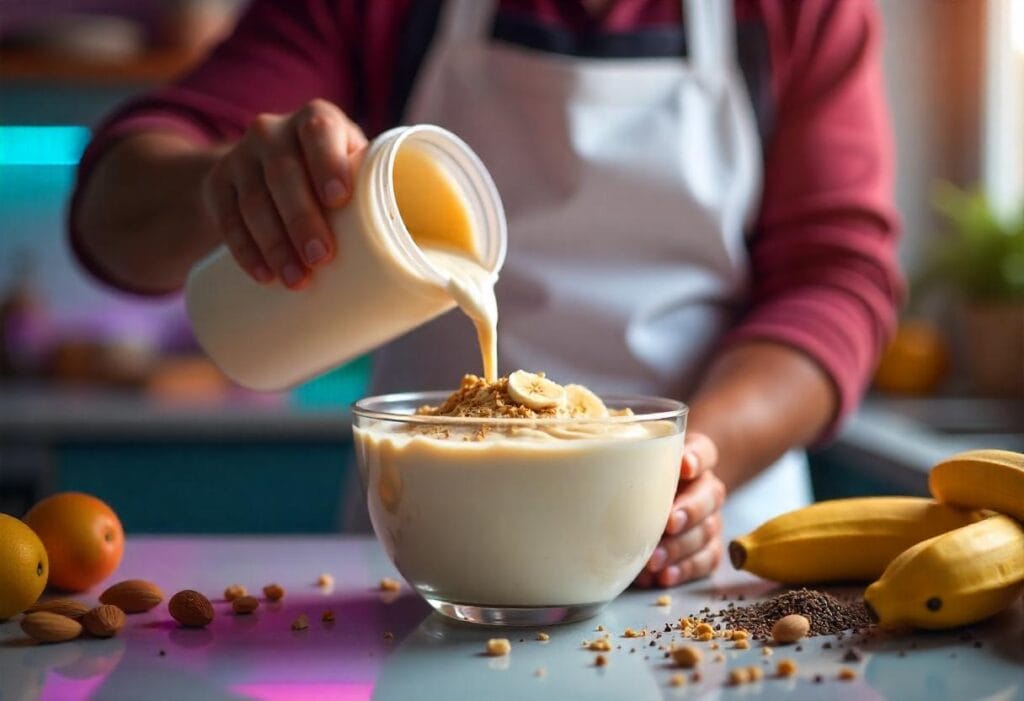Protein pudding is one of those desserts that seems too good to be true: delicious, creamy, and packed with protein. But what exactly is protein pudding made of, and how does it differ from traditional pudding? In this article, we’ll take a deep dive into the ingredients that make up this popular treat and explore how protein pudding can be a healthy and satisfying dessert option.
Introduction: The Rise of Protein Pudding
You’ve probably seen protein pudding popping up everywhere—on fitness blogs, in Instagram posts, and even in your favorite health stores. But what exactly makes this pudding so special? Well, protein pudding isn’t just any dessert. It’s a way to get a protein boost while indulging in something sweet.
So, what is protein pudding made of? At its core, protein pudding combines protein powder with various other ingredients to create a creamy, delicious treat. But the magic comes from knowing the right ingredients and how they work together. Whether you’re making it from scratch or buying a pre-made version, protein pudding can be a healthy dessert option that satisfies your sweet tooth and fuels your body at the same time.
Why Protein Pudding is Gaining Popularity
People love protein pudding because it’s a versatile and healthier option for dessert or a snack. It’s packed with protein, which is essential for building and repairing muscles, making it a popular choice for athletes and fitness enthusiasts. But it’s also a great option for anyone looking to make a healthier choice without sacrificing flavor.
Protein pudding is especially appealing for those who want to reduce their sugar intake or follow a specific diet plan, like low-carb, keto, or vegan. Since protein pudding can be made with different types of protein powders and liquids, it’s easy to customize to meet your dietary needs. Plus, it’s incredibly easy to make, making it a perfect go-to snack when you’re craving something sweet and filling.
The Basics of Protein Pudding: What Are the Key Ingredients?
Now that we know why protein pudding is so popular, let’s dive into the basic ingredients that go into making it. If you want to make your own protein pudding, it’s essential to understand what ingredients are typically used, what they do, and how to combine them for the perfect texture and flavor.
Protein Powder: The Heart of Protein Pudding
Protein powder is the key ingredient in protein pudding, and it’s what gives this dessert its protein punch. There are several types of protein powders available, including:
- Whey Protein: This is the most popular type of protein powder, derived from milk. It digests quickly and provides a creamy texture when mixed into liquids, making it a great choice for pudding.
- Casein Protein: Also derived from milk, casein protein digests more slowly than whey protein. This gives protein pudding a thicker, more custard-like consistency, making it perfect for a rich, creamy treat.
- Plant-Based Proteins: For those who follow a vegan or dairy-free lifestyle, plant-based proteins like pea, hemp, or brown rice protein can be used instead. These proteins work well in pudding and provide a slightly different texture, but they can still be smooth and delicious when mixed properly.
Block Quote:
« Protein powders are the magic ingredient that turns a simple dessert into a muscle-building snack, making protein pudding a go-to for fitness enthusiasts! » 💪
When choosing a protein powder, it’s important to consider the flavor and sweetness. Flavored protein powders like chocolate or vanilla can add extra taste, so you might need less sugar or sweetener in your recipe. On the other hand, unflavored protein powders give you more flexibility to control the taste.

Liquids: Milk, Non-Dairy Alternatives, and More
To make protein pudding, you need a liquid to help the protein powder dissolve and create the creamy texture that pudding is known for. Traditional pudding uses milk, but protein pudding can be made with a variety of liquids, depending on your dietary needs and flavor preferences.
- Dairy Milk: Whole milk or skim milk is the most common liquid used in traditional pudding. It provides a smooth, rich base that blends well with the protein powder. Milk also adds some natural sweetness and creaminess.
- Non-Dairy Milk: If you’re vegan, lactose-intolerant, or just prefer dairy-free options, plant-based milks like almond, coconut, or oat milk are great choices. These alternatives offer different flavors, so choose one that complements your protein powder.
- Water or Juice: In some cases, water or even fruit juice can be used as the base liquid. Water is the most neutral option, but it can result in a thinner texture. Fruit juice, like orange or apple juice, can add a fruity twist to your protein pudding, but it may require some adjustments in sweetness.
Sweeteners: How to Make Your Protein Pudding Taste Great
Protein pudding needs to be sweetened to bring out the flavors and balance the taste of the protein powder. There are several options when it comes to sweeteners, so you can choose one that fits your dietary needs.
- Natural Sweeteners: Stevia, monk fruit, and erythritol are all popular natural sweeteners. These options are calorie-free and don’t spike blood sugar, making them perfect for people on low-carb, keto, or diabetic diets.
- Sugar: Traditional sugar, honey, and maple syrup are great choices if you want a natural sweetener. While they do add calories, they provide a richer, more familiar sweetness. Just be sure to use them in moderation to keep your pudding from becoming too sweet.
- Sugar Alcohols: Xylitol and erythritol are common sugar alcohols used in low-sugar recipes. They provide sweetness with fewer calories than traditional sugar but can have a slight aftertaste.
Thickeners: Creating the Perfect Texture
One of the most important parts of making protein pudding is achieving the right texture. If your pudding is too runny or too thick, it won’t be as enjoyable. This is where thickeners come in.
- Cornstarch: Cornstarch is commonly used to thicken pudding. It helps the liquid bind together and creates that smooth, custard-like consistency we all love. For protein pudding, cornstarch works especially well when mixed with milk or dairy-free milk alternatives.
- Gelatin and Agar-Agar: These are natural thickeners used to create a firmer, more set pudding. Gelatin is derived from animal collagen, so it’s not suitable for vegans. However, agar-agar, a seaweed-derived product, is a plant-based alternative that works similarly.
- Chia Seeds: Chia seeds are a natural thickener that also add fiber and healthy omega-3 fatty acids to your protein pudding. When mixed with liquid, chia seeds absorb water and expand, creating a thicker, pudding-like texture.
- Psyllium Husk: Like chia seeds, psyllium husk absorbs liquid and thickens your pudding. It’s a good source of fiber and can help create a smooth consistency.
Common Problems When Making Protein Pudding and How to Solve Them
Protein pudding is fairly simple to make, but you might run into a few issues along the way. Here are some common problems and their solutions to ensure your pudding turns out just right.
Lumpy Protein Pudding: How to Achieve a Smooth Texture
One of the most common problems people face when making protein pudding is the texture. Sometimes, the protein powder doesn’t dissolve properly, leaving lumps in your pudding. To fix this:
- Use a blender: If you’re mixing by hand, it’s easy for lumps to form. A blender or hand mixer will help break up any clumps and create a smooth, creamy texture.
- Sift the protein powder: Sifting the protein powder before adding it to the liquid can help eliminate lumps and ensure it blends evenly.
- Whisk continuously: When adding protein powder to your liquid, whisk continuously to prevent clumping. This is especially important if you’re using a thicker protein powder like casein.
Runny Protein Pudding: How to Thicken It
If your protein pudding ends up too runny, it can be disappointing. Here’s how to thicken it:
- Add more thickening agent: If you’re using cornstarch, add a little more, or use a thicker alternative like gelatin or chia seeds.
- Chill it longer: Protein pudding often thickens more as it sits in the fridge. Let it chill for at least an hour or overnight for the best results.
- Reduce the liquid: If you’ve added too much liquid, try cutting back on the amount next time to achieve a firmer consistency.
Nutrition Facts for Protein Pudding (Per Serving)
| Nutrient | Amount |
|---|---|
| Calories | 180 |
| Protein | 25g |
| Carbohydrates | 12g |
| Fat | 6g |
| Fiber | 3g |
| Sugars | 5g |
How to Make the Perfect Protein Pudding: Step-by-Step Instructions
Making protein pudding is a fun and easy process, and once you get the hang of it, you can whip up a batch in no time. Whether you’re using a protein shake or protein powder, there are a few simple steps to follow to ensure that your pudding turns out perfectly every time.
Mixing Your Ingredients for the Best Consistency
The key to a smooth and creamy protein pudding is mixing your ingredients properly. Here’s how you can do it:
- Start with your protein powder: Choose your protein powder (whey, casein, or plant-based) based on your dietary needs and flavor preferences.
- Add your liquid: Pour your milk, non-dairy milk, or other chosen liquid into a bowl. Make sure it’s at room temperature or slightly warm, as cold liquids might cause the protein powder to clump.
- Add any sweeteners or flavorings: Depending on your protein powder’s flavor, you may need to add sweeteners like stevia, monk fruit, or a small amount of honey. You can also add vanilla extract, cinnamon, or cocoa powder for extra flavor.
- Mix it well: Whisk or blend the ingredients together until the protein powder is fully dissolved and the mixture is smooth. If you’re using a thickener like cornstarch, add it at this point and whisk it in.
- Adjust the consistency: If your pudding is too runny, you can add a bit more thickening agent, or let it chill longer. If it’s too thick, add a little more liquid until you reach the desired consistency.

Adjusting Sweetness and Texture to Your Preference
Protein pudding can be customized to your taste. You might prefer a sweeter or more savory flavor, or maybe you like your pudding on the thicker side. Here are some ways to adjust:
- Sweetness: Taste your pudding before chilling it. If it’s not sweet enough, add a little more sweetener. Remember, protein powders often come pre-sweetened, so taste first and adjust as necessary.
- Texture: Protein pudding can range from thick and custard-like to smooth and pudding-like. To thicken it, add more cornstarch, gelatin, or chia seeds. For a lighter pudding, use less thickener and more liquid.
How Long to Chill Your Protein Pudding for Optimal Results
Chilling your protein pudding is essential for achieving the right texture. While you can technically eat it right after mixing, the pudding will firm up and become even creamier once it’s been in the fridge for at least an hour. For the best results, leave your pudding in the fridge overnight. This allows all the ingredients to settle, thicken, and create a smoother, richer texture.
Common Problems When Making Protein Pudding and How to Solve Them
Even though making protein pudding is simple, a few issues can arise along the way. Here’s how to fix them!
Lumpy Protein Pudding: How to Achieve a Smooth Texture
Lumps are one of the most common problems when making protein pudding. Protein powder can sometimes clump together if not properly mixed. Here’s how to solve it:
- Use a blender or hand mixer: This helps break up any clumps and ensures your protein pudding is smooth. A whisk can work, but a blender makes the process much easier.
- Sift your protein powder: Sifting the protein powder before adding it to the liquid will help prevent any clumps from forming.
- Whisk continuously: Don’t stop whisking as you mix in your protein powder. This will help prevent lumps from forming.
Runny Protein Pudding: How to Thicken It
If your protein pudding is too runny, it could be because you’ve added too much liquid. Here’s how to thicken it up:
- Add a thickening agent: Cornstarch is a common thickening agent for protein pudding. Just mix 1–2 tablespoons of cornstarch with a little cold liquid, then stir it into your pudding. Let it heat on the stove for a few minutes until it thickens.
- Let it chill longer: Protein pudding often thickens as it cools. If it’s still too runny, let it sit in the fridge for an hour or two to thicken.
- Reduce the liquid: If you’re making it from scratch, try reducing the amount of liquid next time to avoid a watery consistency.
Overly Sweet Protein Pudding: Balancing the Flavors
Sometimes, protein pudding can end up too sweet, especially if you’re using flavored protein powder. Here’s how to balance the sweetness:
- Add a pinch of salt: Salt helps cut through the sweetness and balances the flavors, making your pudding taste richer and more well-rounded.
- Use unsweetened protein powder: If you prefer to have control over the sweetness, opt for an unflavored protein powder and add your own sweetener to taste.
- Add some lemon juice: A splash of lemon juice can also help to tone down the sweetness and add a refreshing contrast to the flavors.
Grainy or Chalky Protein Pudding: What Went Wrong?
If your protein pudding turns out grainy or chalky, it’s often a sign that the protein powder didn’t dissolve properly. Here’s how to fix it:
- Choose a high-quality protein powder: Some lower-quality protein powders are more prone to creating a grainy texture. Look for ones that are finely ground and dissolve easily in liquids.
- Blend your pudding: If you’re still getting a grainy texture, blending the pudding can break down the protein powder and smooth it out.
- Add more liquid: If your pudding is too thick or the protein powder didn’t dissolve properly, try adding a little more liquid to help it blend better.
Protein Pudding Variations: Creative Ways to Customize Your Recipe
One of the best parts about making protein pudding is that you can get creative with the flavors and ingredients. Here are some fun and delicious variations to try:
Chocolate Protein Pudding: A Decadent Treat
Chocolate protein pudding is a classic favorite for chocolate lovers. To make it, simply use a chocolate protein powder and add a little cocoa powder for extra richness. You can also mix in some dark chocolate chips or cocoa nibs for an added crunch.
Vanilla Protein Pudding: A Classic with Endless Flavor Options
Vanilla protein pudding is a blank canvas for all sorts of flavor combinations. Add fresh berries, cinnamon, or even a little almond extract to create a dessert that’s uniquely yours. Vanilla is also perfect for layering with other toppings like granola, chopped nuts, or coconut flakes.
Fruit-Flavored Protein Pudding: Fresh, Light, and Refreshing
For something light and refreshing, try a fruit-flavored protein pudding. You can blend in fruits like strawberries, blueberries, or mango, or simply top your pudding with fresh fruit after it’s set. The natural sweetness of the fruit pairs perfectly with the creaminess of the pudding.
Protein Pudding for Different Diets: Which One Works for You?
No matter what type of diet you follow, protein pudding can be customized to suit your needs. Whether you’re following a keto, vegan, or high-protein plan, there’s a protein pudding recipe for you.
Keto-Friendly Protein Pudding: Low-Carb and High-Protein
If you’re on a keto diet, you can easily make protein pudding that fits your low-carb lifestyle. Use a low-carb protein powder (whey isolate works great), and choose unsweetened almond milk or coconut milk as your base. Sweeten with stevia or monk fruit to keep the carbs in check.
Vegan Protein Pudding: A Dairy-Free, Plant-Based Delight
For those following a vegan diet, use plant-based protein powders like pea or hemp protein. Combine with non-dairy milk and natural sweeteners like maple syrup or agave. Vegan protein puddings can be just as creamy and delicious as their dairy counterparts.
High-Protein, Low-Sugar: Ideal for Weight Loss and Muscle Building
If you’re trying to lose weight or build muscle, protein pudding can be a great snack that fits your goals. Choose a protein powder that’s high in protein and low in sugar. Opt for unsweetened liquids and natural sweeteners to keep the calorie count down.
Conclusion: Why Protein Pudding is a Healthy and Delicious Option
Protein pudding is a great way to satisfy your sweet tooth while nourishing your body with a healthy dose of protein. Whether you’re using it as a post-workout snack, a dessert, or even a breakfast option, protein pudding is versatile and easy to make.
The key to making the perfect protein pudding is understanding the ingredients and adjusting the recipe to fit your taste and dietary preferences. From choosing the right protein powder to experimenting with flavors and textures, the possibilities are endless.
So, if you’ve been wondering what is protein pudding made of, now you know—it’s made from protein powder, liquid, sweeteners, and thickeners. Whether you stick with the classic chocolate or vanilla, or get creative with fruit and spices, protein pudding is a healthy, delicious way to boost your protein intake and enjoy a tasty treat.
Nutrition Facts for Protein Pudding (Per Serving)
| Nutrient | Amount |
|---|---|
| Calories | 180 |
| Protein | 25g |
| Carbohydrates | 12g |
| Fat | 6g |
| Fiber | 3g |
| Sugars | 5g |

